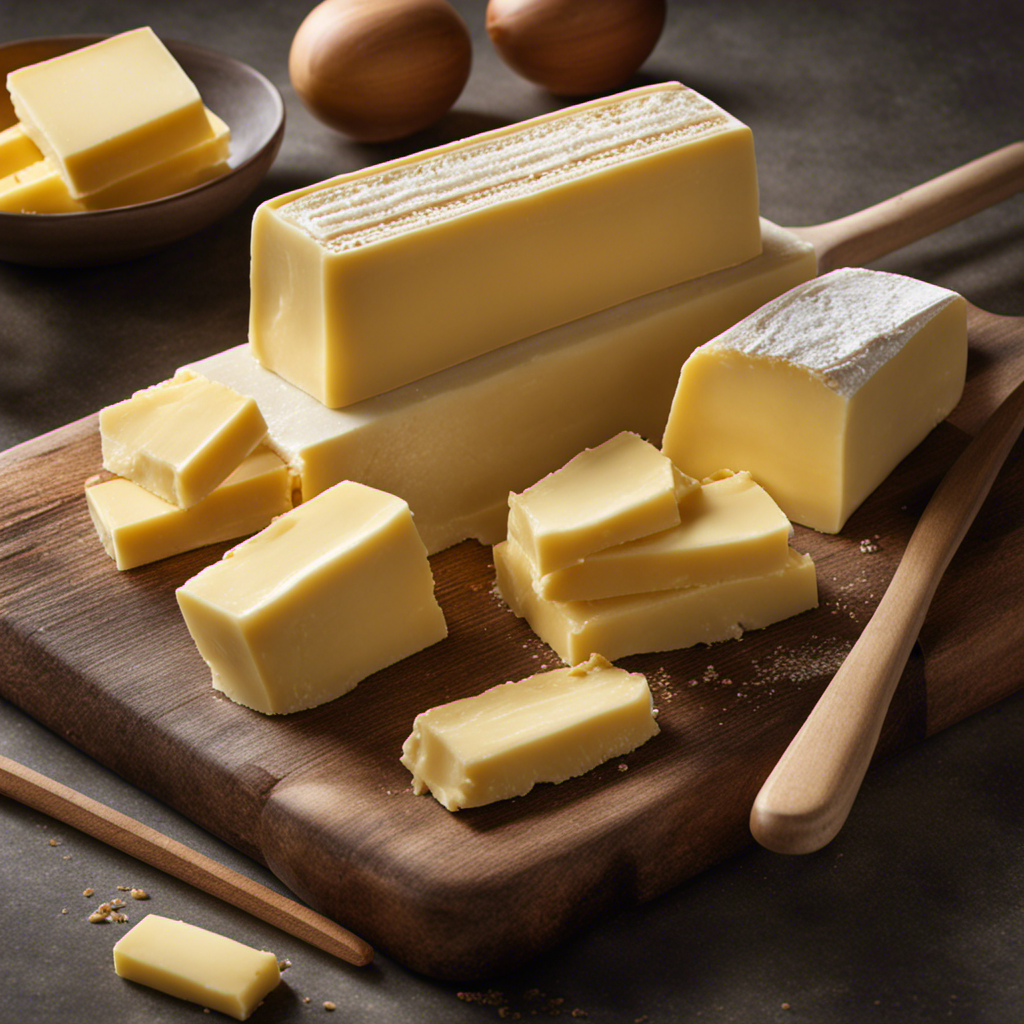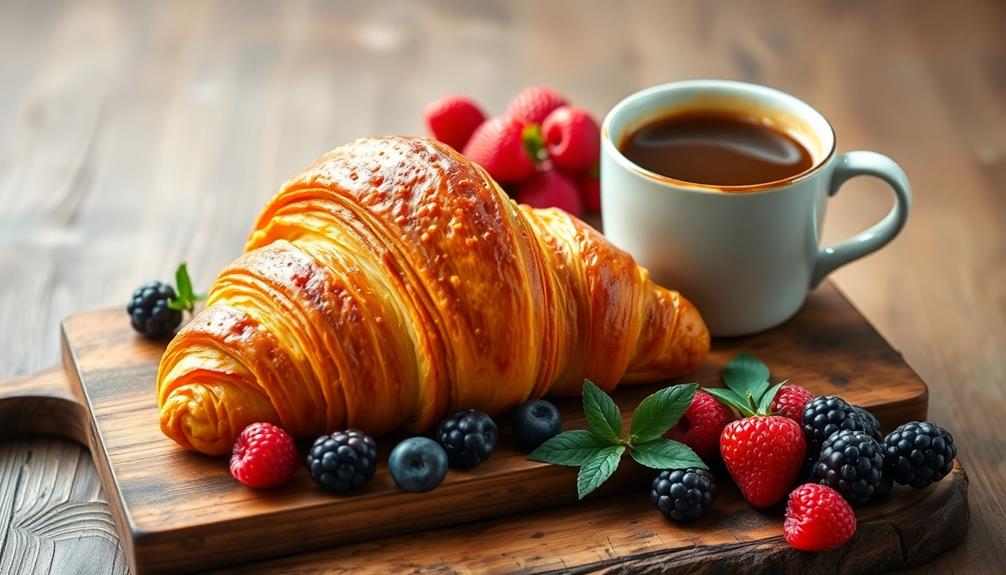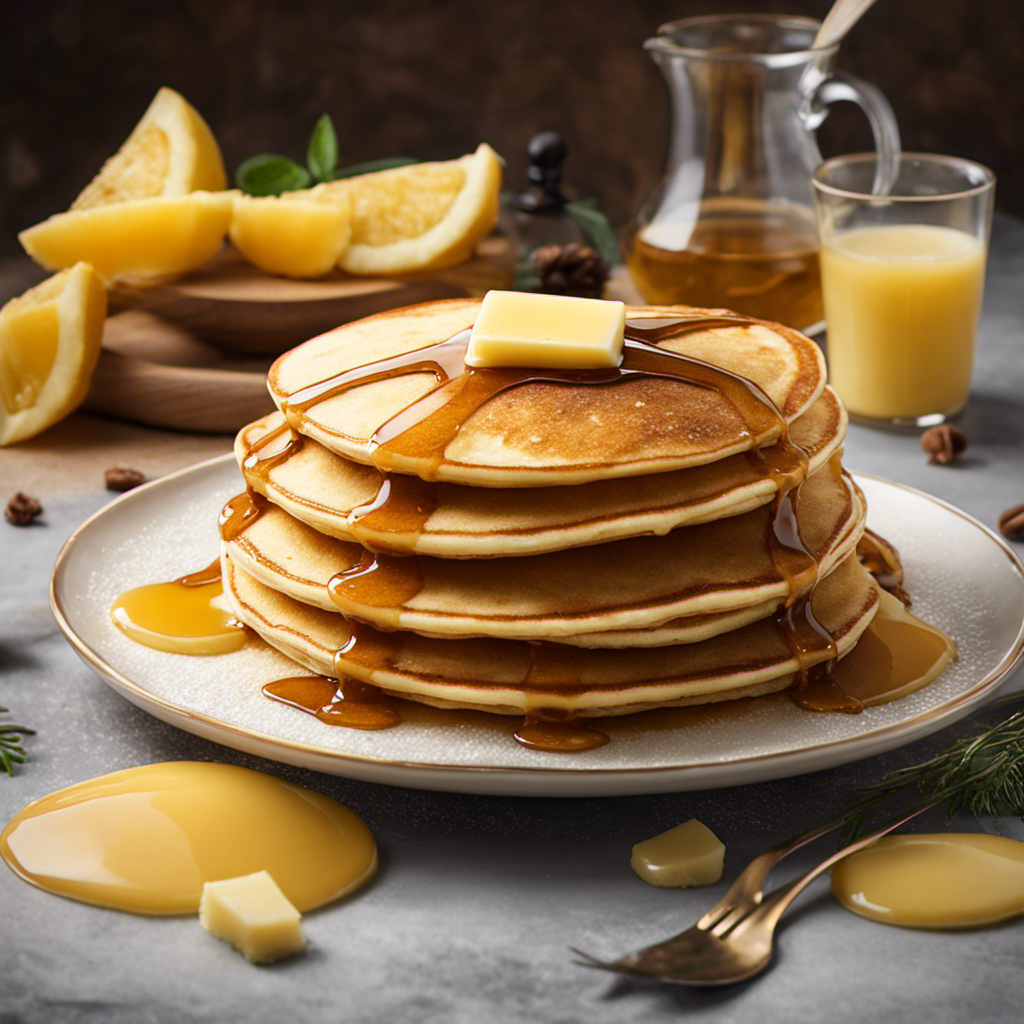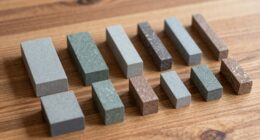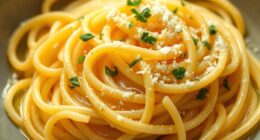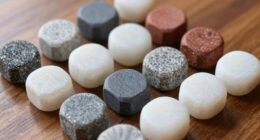As someone passionate about baking and a true lover of butter, I frequently catch myself contemplating the longstanding inquiry: How many sticks of butter does one pound contain?
Well, fear not fellow butter lovers, for I am here to shed light on this buttery mystery.
In this article, we will dive into the world of butter measurements, unravel the secrets of converting sticks to pounds, and even provide you with a handy butter measurement conversion chart.
So grab your aprons and get ready to butter up your baking skills!
Key Takeaways
- One stick of butter is equal to 1/4 pound.
- Most butter packages in the US come in sticks weighing 1/2 cup or 8 tablespoons.
- European butter may have weight variations compared to American butter.
- Weighing butter in grams using a kitchen scale ensures precise and consistent results.
Understanding Butter Measurements
There’s no need to worry about converting measurements, as one pound of butter contains four sticks.
Understanding butter measurements can be helpful when following recipes or trying to determine how much butter you need for a specific dish.
Butter measurement equivalents can vary depending on the country and brand, but generally, one stick of butter weighs 1/4 pound or 113 grams. This means that if a recipe calls for 1/2 pound of butter, you would need to use two sticks.
It’s important to note that butter weight can vary slightly due to moisture content, so it’s always a good idea to weigh your butter for precise measurements.
Converting Butter From Sticks to Pounds
To convert sticks of butter to pounds, you’ll need to know the weight of each stick. Generally, a stick of butter weighs approximately 1/2 cup or 4 ounces, which is equal to 113 grams. Therefore, there are 8 sticks of butter in a pound. However, it’s important to note that different brands may have slightly different weights for their sticks of butter. To ensure accuracy, it’s always best to check the packaging or consult a reliable source for the specific weight of the butter you’re using. Here is a handy table that shows the conversion of sticks of butter to pounds:
| Sticks of Butter | Pounds |
|---|---|
| 1 | 1/4 |
| 2 | 1/2 |
| 4 | 1 |
| 8 | 2 |
| 16 | 4 |
Remember these butter measurement tips to easily convert between sticks and pounds for your recipes.
The Standard Weight of a Stick of Butter
The weight of a stick of butter typically varies depending on the brand. However, most sticks of butter weigh around 113 to 120 grams, or 4 to 4.25 ounces. Here are four interesting facts about butter weight conversions and butter packaging variations:
-
Different brands may have slightly different weights for their sticks of butter. It’s always a good idea to check the packaging for the exact weight.
-
Some countries, like the United States, typically package butter in 1/2 cup or 1 cup sticks, while others may use different measurements.
-
European butter is often sold in larger blocks, typically weighing 250 grams or 8.8 ounces.
-
In some recipes, butter may be measured by weight rather than by stick. It’s important to convert accurately to ensure the right amount of butter is used.
Understanding the standard weight of a stick of butter is crucial when determining how many sticks are needed to equal a pound.
How Many Sticks of Butter Equal a Pound
When it comes to baking, knowing the butter-to-pound ratio is essential. Understanding the measurements of stick butter and how they relate to pounds can make a big difference in the outcome of your recipes.
Converting pounds to sticks can be a helpful skill to have, especially if you come across a recipe that calls for a specific amount of butter in pounds rather than sticks.
Butter-To-Pound Ratio
You can easily determine the butter-to-pound ratio by dividing the number of sticks by the total weight. This ratio is useful when converting butter to grams or when you need to know the butter quantity for cooking recipes.
Here are four things to know about the butter-to-pound ratio:
-
Sticks of Butter: In the United States, butter is commonly sold in 1/2 cup sticks. Each stick weighs 1/4 pound or 113 grams.
-
Pounds to Sticks: To convert pounds of butter to sticks, divide the weight by 0.25. For example, 1 pound of butter is equal to 4 sticks.
-
Grams to Sticks: To convert grams of butter to sticks, divide the weight by 113. For instance, if you have 226 grams of butter, it will be approximately 2 sticks.
-
Recipe Adjustments: Knowing the butter-to-pound ratio helps you adjust recipes. If a recipe calls for 1/2 pound of butter, you can use 2 sticks.
Understanding the butter-to-pound ratio makes it easier to work with butter in different measurements and ensures accurate results in your cooking and baking endeavors.
Stick Butter Measurements
To accurately measure stick butter, simply divide the weight by 113 to determine the number of grams. Understanding butter measurements is crucial for any avid baker or cook.
When a recipe calls for a specific amount of butter, it’s important to measure it accurately to ensure the desired results. Here are a few tips for accurate butter measurement.
First, make sure the butter is at room temperature for easier measuring. Then, using a sharp knife, cut the butter into the desired amount of sticks. Remember, one stick of butter is equal to 113 grams.
Once you have measured the butter, you can proceed with your recipe confidently. Now, let’s move on to converting pounds to sticks.
Converting Pounds to Sticks?
If you want to convert pounds of butter into stick measurements, it’s helpful to know that each pound is equal to four sticks. Converting butter weight can be useful when following recipes that call for specific measurements. Here are four key points to consider when converting pounds to sticks:
-
One pound of butter is equal to four sticks. This is the standard conversion and can be used in most recipes.
-
If you have a recipe that calls for a certain number of sticks and you only have pounds of butter, simply divide the pounds by four to get the number of sticks needed.
-
Conversely, if a recipe calls for a specific number of pounds and you only have sticks of butter, multiply the number of sticks by four to get the equivalent weight in pounds.
-
It’s important to note that butter sticks are typically sold in 1/2 cup measurements, which is equivalent to 1 stick or 1/4 pound.
Understanding the conversion between pounds and sticks allows for easier and more accurate measurements when using butter in recipes.
Calculating Butter Quantity for Recipes
When it comes to baking, knowing the butter to pound ratio is essential. Understanding how much butter is needed for a recipe is crucial for achieving the desired results.
In this discussion, we will explore the conversion of butter measurements, providing you with the knowledge to accurately calculate the amount of butter needed for your favorite recipes.
Butter to Pound Ratio
The butter to pound ratio is four sticks per pound. This information is crucial for understanding butter packaging and for accurate butter quantity calculations in recipes. Here are four key points to help you grasp this concept:
-
Standard Packaging: Butter is typically sold in one-pound packages, which contain four individually wrapped sticks.
-
Stick Size: Each stick of butter is usually 1/2 cup (8 tablespoons) or 113 grams.
-
Fractional Measurements: If a recipe calls for a fraction of a pound, like 1/2 pound, you can easily measure it by using two sticks of butter.
-
Conversion: If a recipe specifies butter in grams or tablespoons, you can calculate the number of sticks needed by dividing the given quantity by 113 grams or 8 tablespoons respectively.
Understanding the butter to pound ratio simplifies butter quantity calculations and ensures accurate results in your cooking and baking endeavors.
Converting Butter Measurements
Now that we understand the ratio of butter to pound, let’s talk about converting butter measurements and calculating butter quantities.
Converting butter measurements can be a bit tricky, but with a little math, it’s easy to do.
To convert butter from sticks to pounds, you need to know that one stick of butter is equal to 1/4 pound. So, if you have 4 sticks of butter, that would be equal to 1 pound. If you have 8 sticks, that would be 2 pounds, and so on.
When calculating butter quantities, it’s important to keep in mind the recipe you’re using. If a recipe calls for a specific amount of butter in sticks, you can easily convert it to pounds using the ratio mentioned earlier.
Butter Packaging and Weight Variations
To determine how many sticks of butter are in a pound, you’ll want to check the packaging and account for any weight variations. Here are some important factors to consider when it comes to butter packaging and weight variations:
-
Standard Butter Packaging: Most butter packages in the United States come in sticks that weigh 1/2 cup or 8 tablespoons. These sticks are usually wrapped in wax paper and are conveniently marked with measurements for easy slicing.
-
Weight Variations: It’s essential to note that the weight of butter sticks can vary slightly. While most sticks weigh 1/2 cup or 113 grams, some brands may have slightly different weights. Always refer to the packaging for the accurate weight of each stick.
-
Different Butter Packaging Options: Besides the traditional stick packaging, you can also find butter in tubs or blocks. Tubs usually contain spreadable butter, while blocks are commonly used for baking purposes. These alternative packaging options may have different weights and measurements, so be sure to check the packaging for accurate conversions.
-
European Butter Weight Variations: If you’re using European butter, you may encounter weight variations compared to American butter. European butter is typically sold in 250-gram blocks, which are equivalent to approximately 8.8 ounces or 2 sticks of American butter. Always double-check the weight and adjust your measurements accordingly.
Tips for Accurate Butter Measurement
For accurate measurements, it’s important to account for any variations in butter packaging and weight. Understanding butter density is key to measuring it accurately in grams. Butter density refers to the amount of mass packed into a given volume. Since butter can come in different forms, such as sticks, blocks, or tubs, the density can vary.
To measure butter in grams, it’s essential to use a kitchen scale. Place the butter on the scale and adjust until it reads zero. Then, weigh the desired amount of butter in grams. By using grams as a unit of measurement, you can ensure precise and consistent results in your recipes.
Now that we understand how to measure butter accurately, let’s explore butter equivalents in different measurement systems.
Butter Equivalents in Different Measurement Systems
If you’re looking to convert butter measurements, it can be helpful to know that 1 cup of butter is equivalent to 227 grams. However, butter measurements can vary in different countries. Here are some equivalents to help you convert butter from ounces to grams and understand butter measurements in different countries:
-
In the United States, butter is typically sold in sticks. One stick of butter is equal to 4 ounces or approximately 113 grams.
-
In the United Kingdom and Australia, butter is commonly measured in tablespoons. One tablespoon of butter is equal to 14 grams.
-
In Canada, butter is sold in 1-pound blocks. One pound of butter is equal to 454 grams.
-
In France, butter is often measured in grams. One ounce of butter is equal to approximately 28 grams.
Knowing these equivalents can make it easier to convert butter measurements and follow recipes accurately, no matter where you are.
Common Butter Conversions for Baking
When it comes to baking, knowing the equivalents for butter in different measurement systems is essential. Whether you’re using sticks of butter or grams, understanding the conversions will ensure your recipes turn out just right.
Additionally, it’s helpful to know the various options for substituting butter in case you run out or want to make a healthier choice.
In this discussion, we will dive into the world of butter pound equivalents, baking measurement conversions, and butter substitution options.
Butter Pound Equivalents
To find out how many sticks of butter are in a pound, you can simply divide the pound into four equal parts. This butter pound conversion is a helpful way to accurately measure the amount of butter needed for your baking recipes.
Here are four key points to consider:
-
Standard measurement: In the United States, butter is typically sold in one-pound packages, which contain four sticks of butter.
-
Stick size: Each stick of butter weighs 4 ounces or 113 grams, making it easy to measure and use in recipes.
-
Accuracy in baking: Butter measurement accuracy is crucial in baking, as it affects the texture and taste of the final product. Using the correct amount ensures consistent results.
-
Conversion convenience: Knowing how many sticks of butter are in a pound simplifies recipe conversions. If a recipe calls for half a pound of butter, you can easily measure out two sticks.
Understanding the butter pound conversion is just the beginning of mastering baking measurement conversions. Let’s now explore other essential conversions for a successful baking experience.
Baking Measurement Conversions
Understanding the butter pound conversion is just the beginning of mastering baking measurement conversions. There are many other essential conversions to consider. When it comes to butter, it’s important to know the weight equivalents and how to convert butter measurements to metric.
In the United States, butter is typically sold in sticks. Each stick weighs 1/2 cup or 113 grams. To convert this to metric, 1 cup of butter is equal to 227 grams. So if a recipe calls for 2 cups of butter, you would need 454 grams.
It’s important to note that butter can vary in density, so it’s always a good idea to weigh it for accuracy.
Having a good understanding of butter weight equivalents and knowing how to convert butter measurements to metric will help ensure success in your baking endeavors.
Butter Substitution Options
Knowing the various options for substituting butter is essential for those who want to explore alternative ingredients in their baking recipes. Here are four butter alternatives that not only provide a different flavor profile but also offer health benefits:
-
Coconut oil: This tropical oil is a popular choice for replacing butter in vegan and dairy-free recipes. It adds a subtle coconut flavor and can be used in equal amounts as butter.
-
Avocado: Mashed avocado can be used as a butter substitute in recipes like brownies and cookies. It adds a creamy texture and healthy fats to your baked goods.
-
Greek yogurt: When baking, you can replace half the butter with Greek yogurt for a moist and lighter texture. It also adds protein and calcium to your treats.
-
Applesauce: A common substitute for butter in baking, applesauce not only adds moisture but also provides natural sweetness and fiber.
Adjusting Butter Amounts in Recipes
When adjusting butter amounts in recipes, you’ll need to know how many sticks of butter are in a pound. This knowledge is essential to ensure accurate measurements and achieve the desired results in your baked goods.
To accurately adjust butter measurements, here are a few tips to keep in mind. Firstly, one pound of butter is equal to four sticks or 2 cups of butter. If a recipe calls for less than a pound, you can easily divide the sticks accordingly. For example, if you need half a pound of butter, you will use two sticks.
Additionally, if your recipe calls for softened butter, make sure to measure it correctly by packing it into a measuring cup. By following these tips, you can confidently adjust butter amounts in recipes and achieve delicious results every time.
Handy Butter Measurement Conversion Chart
To accurately adjust butter measurements in recipes, it’s helpful to refer to a handy conversion chart. Here are four key points to consider when using a butter measurement conversion chart:
-
Understand the weight conversions: Butter is commonly sold in sticks or in pounds. One pound of butter is equal to four sticks or 16 ounces.
-
Convert from pounds to sticks: If a recipe calls for a certain number of sticks and you only have butter in pounds, divide the pound measurement by 0.25 to determine the number of sticks needed.
-
Convert from sticks to pounds: If a recipe calls for a certain number of pounds and you only have butter in stick form, multiply the number of sticks by 0.25 to determine the equivalent pound measurement.
-
Adjust butter quantity for cooking: The conversion chart can help you accurately adjust the amount of butter needed for various recipes, ensuring the right balance of flavor and texture in your dishes.
Frequently Asked Questions
Can I Use Margarine Instead of Butter in a Recipe?
Sure, you can use margarine instead of butter in a recipe. Margarine is a butter substitute that has a similar texture and taste. The pros are it’s lower in saturated fat, but the cons are it may affect the taste and texture of the dish.
How Many Ounces Are in a Stick of Butter?
How many tablespoons are in a stick of butter? Well, let me tell you, there are 8 tablespoons in a stick of butter. And if you don’t have a scale, each tablespoon is about 1/2 ounce.
Can I Substitute Oil for Butter in Baking?
Yes, you can substitute oil for butter in baking. Baking with coconut oil is a popular option. Another alternative is using applesauce as a butter substitute, which can add moisture and a hint of sweetness to your baked goods.
How Long Does Butter Last in the Refrigerator?
In my experience, butter typically lasts about 2-3 weeks in the refrigerator. To properly store it, keep it wrapped or in an airtight container. Leftover butter can be used for cooking or baking.
Is It Necessary to Use Unsalted Butter in Baking Recipes?
In my experience, using unsalted butter in baking recipes is necessary. It allows for better control of the salt content and helps achieve a more balanced flavor and texture in the final product.
Conclusion
In conclusion, understanding butter measurements is like unraveling a delicious mystery. Converting from sticks to pounds may seem daunting, but fear not! Armed with the knowledge that there are four sticks in a pound, you can conquer any recipe that comes your way.
Whether you’re baking a batch of cookies or whipping up a creamy sauce, this handy butter measurement conversion chart will be your trusty sidekick. So go forth, butter enthusiasts, and let the magic of precise measurements elevate your culinary creations to new heights!
